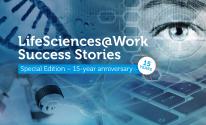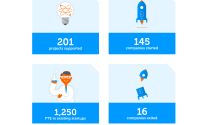
Hybridize Therapeutics
Their road to success
INTERVIEW
with Eline van Beest and Eric van der Veer
For this interview, we talked with Eline van Beest and Eric van der Veer, both committed to their startup Hybridize Therapeutics, founded by Eric in 2019. Eline joined Hybridize as a second-time CEO. The interview covers their separate experiences in winning the Venture Challenge and we take a look at how they are doing now.
How Hybridize started
Van der Veer, founder and Chief Innovation Officer at Hybridize, worked as a postdoc in the renal field for over eight years at Leiden University Medical Center. After a disappointing experience, he decided to take his research results and spin out of the university. ‘During my PhD, I developed interesting technology, which was licensed out to a large pharma company. My IP ended up on their shelves and wasn’t used to innovate and help patients. I would not let that happen again, so years later, I decided to try and make an impact myself.’ It wasn’t easy to spin out. It took long negotiations with the university regarding IP.
Van der Veer also needed a different mindset and a team. Looking back, he is very glad someone told him about the Venture Challenge. ‘Before participating, I thought about what the packaging of our drug should look like, not knowing that our scientific understanding wasn’t nearly enough to bring a drug to the market. I also thought that investors would simply love my idea, but they gave me a cold shower at first. I quickly learned that doing business is very different from doing science.’

On the hunt for a CEO
Through the Venture Challenge network and his own connections, Van der Veer aimed his arrows at Van Beest as a potential CEO. ‘This is what I call a ‘Leiden thing’. The people in this network are cowboys in the best sense of the word. They saw the potential of Hybridize and decided to help me. I decided that Hybridize needed a CEO, and after a lot of deliberation, we contacted Eline.’ Van Beest: 'It took four months before I said yes. I initially didn’t want to do it because my experience lies in MedTech. I eventually accepted with the condition that I would have Dinko Valerio, a highly experienced pharma entrepreneur, as my business coach.’
Being a jury member
Van Beest entered the Venture Challenge in 2010 and won the €25,000 cheque with her MedTech startup NightBalance. The sleep position trainer she developed at TU Delft prevents sleep apnea. The successful company, holding 15 patents and commercially active in 6 countries, was sold to Philips 8 years later. With the experience she had gained over the years, Van Beest was asked to become a Venture Challenge jury member. She took this role in 2016 and 2018.
From MedTech to Biotech
There are big differences between running a Biotech company versus a MedTech company. Van Beest knows first-hand. ‘MedTech is so much more predictable. In Biotech, you can test your product in human cells and in animals and then there is still a huge risk of it not working in humans. In MedTech that risk is much lower. That enormous risk is something that fascinates me in Biotech.’ Van der Veer adds: ‘Because of that risk, we had to create a pipeline of new medicines. If our first drug fails, we don’t fail as a company. It is a de-risking strategy.
De-risking
Strategy

Second-time CEO
As a second-time CEO, many aspects of running a startup are familiar to Van Beest. One advantage of her previous experience is that she knew exactly which questions investors would ask. ‘In my first six months at Hybridize, we focused on a clean dataset in a dataroom, creating reports on market sizing and reimbursement value, for example. We really needed the business knowledge next to the science to convince investors.’
But first, a licensing deal was needed. ‘The university needed us to have investors on board before they would give us the licensing deal. Of course, no investor is interested when you’re not allowed to use the IP on which the product is based. So, I said to the university, “okay guys, if you want this to work, we need a license deal”. After some negotiation we came to an agreement.
Van Beest also knows how to set up a company for operational success. ‘From my time at NightBalance, I knew which software and IT systems would work well for Hybridize, which legal party I wanted to use, which accountant, etc. That saved us a lot of time and effort.’ One of the most important things Van Beest learned from NightBalance was not to do everything herself. ‘At that time, I felt it was my idea, product, and innovation.
I found it hard to let other people do the work, and I would comment on it when they did. I learned that this is not the way to empower people in their role. Now I let people do things their way, even if it is very different from how I would do it. If the outcome is good, I’m happy’. Van Beest is also far more comfortable with the financial instability that comes with a startup.
‘I hired fantastic people, also senior people at an early stage. I just started with renting labs and setting up an office. Even though we didn’t know for sure if we could pay for all of that, we built for success and as a result, we can execute the investment deal we made well. Of course this needs to be realistic and well-balanced, but it becomes a self-fulfilling prophecy.’








